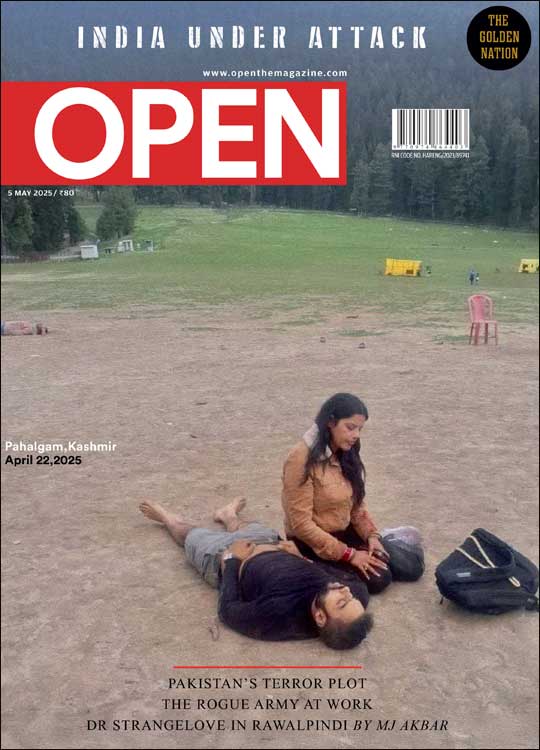Bound Free
India’s underground BDSM practitioners want Bondage-Discipline-Sadism-Masochism seen as alternative sexuality, not deviant behaviour
 Chinki Sinha
Chinki Sinha
 Chinki Sinha
|
09 Dec, 2013
Chinki Sinha
|
09 Dec, 2013
/wp-content/uploads/2015/11/bssm-1.jpg)
India’s underground BDSM practitioners want Bondage-Discipline-Sadism-Masochism seen as alternative sexuality, not deviant behaviour
She lay on a bed of stones. Ants bit her skin, but she stayed still, not even scratching herself. She was forbidden to. He had told her to not move until a butterfly alighted on her body. It must have been an hour. Maybe more. She can’t tell. But a butterfly did eventually land on her. It marked the completion of a task. There were other orders too from the man she refers to as ‘Huzoor’, tasks assigned to a ‘sub’ by the ‘dom’.
It was behind a cottage on top of a hill somewhere in Karnataka. They had gone for a session there. “It was a beautiful place,” she says. “He was watching me all the time. I had surrendered to him.”
They met soon after she joined a BDSM—Bondage, Discipline, Sadism and Masochism—forum on the internet. A friend had referred him to her. Sessions could be held either online or offline. There could be multiple partners. It could mean subversion. Or, as most would say, perversion.
She is 49. She has fought for many causes. As a feminist, an activist and much else. But she won’t judge herself for her fantasies. Those exist in a different realm. A place where desire is supreme and can be converted to reality at a pinch, if only for a short while. Almost nothing here is taboo. And pain is pleasure. She wasn’t bothered about personalities. The person would cease to matter in that moment. Beyond a few questions, she wanted no details. Nor did she divulge any. All she wanted was to push her limits of adventure. So when a man said “I love you” in the midst of a session, she didn’t know how to handle it. By BDSM community custom, love was to be kept out.
She eventually figured he was playing with her mind. He vanished, but left her thinking about love and its kinky reality. Why is love kept out of role play?
“Because love is love, it’s up there,” she says. “It is sacrosanct. There are many in the community who are in love, many more who want to be in love. But now some of us are discussing this. Perhaps love can be part of role play.”
In India, BDSM often earns a stigma. It is seen as a psychological disorder. One objection to it is its inequality of engagement. This is inherent in its practice. There is a master or mistress and there is a slave. There is dominance and there is submission, the willing suspension of choice, freedom and other such ideals.
A physical injury is always a possibility, though its practitioners say it is rare. Care is taken on safety. And the key is consent. There are limits that must be negotiated and set mutually before a session.
Pain is real. Everything else could be fantasy. Which is why there are contracts, either written or spoken. It demands a clinical knowledge of kinks, which is a privilege of India’s educated elite with access to the internet. Yet, everyone out there is kinky, believes the 49-year-old. “[Even] love bites are an expression of kink.” She is a spokesperson of the Kinky Collective, a BDSM club and advocacy group.
Cigarette dangling by her hand, she speaks of it as a “junoon”, in which surrender to a dom’s will is something of a spiritual experience. “Intensity is when nothing else matters,” she says. “It is about timelessness… not pain. The intensity is enabled by this person [who doesn’t] matter in the end.”
She calls herself a late bloomer. At 35, she heard a young woman articulate the rights of the LGBT community and fell in “lust” with her. She chased her. They had a relationship. By 46, she’d figured she was kinky.
Right now, she isn’t feeling too well. There’s a chill in the air. Wrapped in a shawl, she slumps on a sofa, an ashtray by her side. She speaks of Kinky Collective’s daring photo exhibition ‘Bound to be Free’, the first of its kind in India. It’s going from city to city. Delhi, Bangalore, Kolkata and then onwards. The idea is to dispel myths about BDSM and stop eyebrows from being raised someday.
Five years ago, she caught a sight that left an impression on her. At a fetish ball in a Brighton basement that she attended with her girlfriend and other friends, she saw a man seated with one woman by his side and another at their feet, resting her head first on his lap and then on hers. Her face bore no sign of humiliation. It was deeply moving, she recalls. Like poetry. As the man patted her, she seemed so at peace in her surrender. There was some beer spilt on the floor. The man took off his coat and spread it out so she wouldn’t get wet.
“That was surreal,” she says. “Loss of dignity. That’s what’s so haunting about it.” There is beauty in the collapse of ego, she adds.
“Everyone has a fetish,” she says.
This is a difficult conversation. She is nervous of me, an outsider, maybe an intruder. And I have already made my first error. I asked her about ‘paraphernalia’.
“We don’t call it that. Those are tools,” she says. “You are welcome to see those. It is about the mastery of senses.” It is not about tools and costumes and role play, as I discover. Forget the preconceptions. It’s not even about sex.
Tucked away in Delhi’s Lado Sarai, there are 40 photographs on display at Abadi Art Gallery. These have been taken by members of the community. Stillettos dug into a man’s throat, blindfolds, whips and chains, melting wax and leashes, there’s enough to cue visual stereotypes. The point, however, is to shatter the notion that BDSM is misogynistic. There are women dominants. There are male submissives. It is about power flow, says the Collective spokesperson. Gender is of no consequence.
In a hazy photograph, a woman drinks milk from a bowl. It’s the ‘reward’, someone says. She was playing the role of a dom’s puppy. The woman is seen in other pictures as well: as a domme (a female dominant) in the one with stillettos at a man’s throat; and then laughing, cigarette in hand, with her feet on top of a man lying prostrate in another.
The photos are not explicit. They are not meant to shock the uninitiated, but evoke interest in the strange. And it’s bizarre just knowing that the people in the pictures are present in the hall.
Reality and fantasy can co-exist, evidently. Like the face of a woman wrapped in cellophane. Or the dog collar around a woman’s neck in a car, with a CNG auto-rickshaw in the frame. It’s Delhi. There is also a photo of a man with wax being poured on his back. “No gain without pain,” someone says, and chuckles. For many, it is erotica. But it is also much more.
Another picture has a cage, with a whip and heels of steel in focus. The man in the cage, you can’t quite see. I later see the same cage at the spokesperson’s place. It was a prop for a game played at a Collective do. To get into the cage, the man had to squeeze himself on all fours over the iron mesh.
Of the 150 odd people who’ve visited the Delhi exhibition, the organisers know only six as members of the BDSM community. “They are afraid,” she says.
Not everyone can understand the photos. Or the fact that people with routine work and family lives can harbour such fantasies. And act on them.
She feels liberated talking about the exhibition, about her choice of lifestyle, about her attraction for another woman. “I would think about her, and it was like my bed was on fire,” she says. “I had to come out to my mother. This had to be the bravest thing I did, and I moved out of the house. People are paranoid of the media. There is a history of fear in the BDSM community.”
But it’s time perhaps for people to come out of the closet, she says. Most of the mainstream would agree that EL James’ Fifty Shades of Grey broke the silence on BDSM. But she and others of Kinky Collective had burnt the book at a fundraiser for the exhibition (which has a photo of shreds of the book with rose petals): to their mind, the book does BDSM a disservice by turning preference into pathology. “BDSM is about consent. Consent is sacred,” she says, “We have rules.”
At workshops held in the privacy of homes, Collective members meet to discuss issues and conduct skill sessions—training in wax play, whipping or rope tying. Never whip the stomach. That could hurt, she says. Certain things are off limits entirely. Like paedophilia.
“But isn’t that desire?” asks a voice.
“Where is the consent there?” she responds.
There is much that the vanilla world needs to understand of BDSM, she tells me. “They can learn from us [the finer points of] consent. As someone who has been part of the women’s movement for 30 years and fought against violence against women, I have learnt a lot about consent after joining this community in which consent is not assumed, it is proactively sought and given, negotiated. Even more importantly, what makes it powerful and real is that it can be withdrawn instantly and unconditionally. Limits are spoken about and pushed.”
So, is BDSM where LGBT was as a community of alternate sexuality some years ago? She dislikes labels, but sees it as a valid comparison. “I feel differently about identity,” she says, “Everyone has experienced power in sex, the wrist being held if even for a moment, or rough sex… I believe this is a sexual orientation.”
Yet, how long it takes for them to emerge from the closet without being branded perverts is hard to say. Kinky Collective has only 21 members right now. But there is a long way to go.
After joining the community online, she had gone into the garden and taken a photo of herself next to an iron grill wrapped by a creeper. It was her profile photo on the BDSM site for a long time. She says she felt like that vine— dependent.
Her feminism was incidental. She was both that and this. “This too is real,” she says, “It’s my erotic reality…”
It’s magic for her, playing with intensity. She compares it with Hindustani classical singing, which she is learning. It is a discipline that allows creativity.
“When I first came into this, I was a sub in a hurry,” she says. “My friends in the community told me to slow down, so I did. But after I met the first dominant who I knew I could trust, within 12 days, I was on my way to Rishikesh for a session. It is about trust and faith. That we have in abundance.” While there are pre-defined limits and safe words (used to call a stop if it gets too much), she says she usually doesn’t push for adventure beyond certain boundaries. One non-negotiable for her is that she won’t eat meat.
As she stubs yet another cigarette, Nusrat Fateh Ali Khan’s dhamaal playing in the background, she speaks of an especially intense experience. “My dom in that session was a sadist and very experienced. In my journey of pain, I went into a kind of space that was trance-like. In the community, we call it the ‘sub space’.”
It’s a space of nothingness. “It is still and calm. I didn’t want him there then.
In my state of collapse, I wanted to be alone.”
Aftercare, she says, is important. That’s one of the things they talk about in their meetings.
Is that a pleasure, then, at the end?
“For me, it’s difficult to call it pleasure. It is just pain, the intensity of the moment. It is not that I don’t dread these sessions. Yet if the whipping stops, I am disappointed,” she says. “I am definitely turned on. I want to cease to exist. That is the only thing in life. It is a spiritual journey for me. It didn’t happen with meditation. We are just mediums for power flow. It is like singing. How to best let the notes flow. It is a trance.”
Some of her sessions have been rather ritualistic. Some pushed her own boundaries in a way that liberated her feelings. One dom asked her to send him her pictures everyday. She was apprehensive, but gave in. “That’s how a dom understands you, releases you, empowers you.” Another dom asked for a striptease. She rehearsed for it, began the show in a pink sari, and danced to the beat of a Bollywood song. “It is wonderful not to have a choice,” she says. “If I am a good sub, I will let you take me on any journey.”
She speaks softly, in measured words. “BDSM helps me distill parts of fantasy within reality,” she says. “I long for a daddy figure. But it isn’t incest. It is not about debunking my feminism. The fantasy here is about unconditional love. That daddy doesn’t exist. Even if he did, he couldn’t rule me in that way. In my BDSM, I want it. I can even get it.” Kinky sex is not new to India, she asserts. “You only have to look at the Kamasutra. The articulation of it could well be, but speaking about such issues requires courage of a different kind.”
Yet, she knows she can’t speak about it in broader settings—say, in a village where she does social work. Open conversations will have to wait. And this is not elitism, she says.
In one of her sessions, she injured an eardrum. She was told to tell the doctor it happened because she fell down. She’d wanted to tell the truth, but dared not.
Until there is openness, it is difficult to solicit honest medical advice on the safety of edgier BDSM practices: a core concern for many. “We [also] want to speak to mental health professionals. Why should we make up stories? Awareness needs to be there,” she says. “This isn’t perversion. We have a meeting coming up soon with some doctors to discuss this.”
As a child, he would tie himself to the handles of French windows at his grandfather’s house with cords pulled out of bolsters. His parents’ only concern was that he should not hurt himself. But he would pretend he’d been captured. It was a bondage fantasy. “Maybe I didn’t know the terminology,” he says over the phone from Kolkata, “I have been into it since very young.”
A lawyer, he is a founder member of Kinky Collective, which was set up in 2011. Overall, though, he has been a close associate of the community for more than ten years now. Many see it as a ‘lifestyle’ choice, but that’s a misportrayal he believes. Just as homosexuality is not a ‘style’ one acquires, neither is this.
For many years, he thought something was wrong with him. That was before the internet and he had no one to discuss it with. “I used to think I was the only one in India with this disease,” he says, “I wasn’t sure if it had anything to do with sexuality. I thought the rest were in America. I was almost in my late twenties then. In 1998, I had my first computer with a dial-up net connection. The point is that there was no exposure to media. There was no pornography then to tell me about it.”
That it was a natural urge, he learnt later. He was inducted by an email from someone asking him whether he was into BDSM. At first, he thought it was spam. However, he did reply, and was pleasantly surprised to get a response from a woman in Bombay who was compiling a list of BDSM practitioners for a social network. “In 2003, I travelled to Bombay and met others like me,” he says, “It was real, it was fun.”
Afraid of an adverse reaction till then, he had avoided any attempt at BDSM in his personal relationships. It was with new courage that he quipped to his partner that if she was tired of his teasing and troubling her, she ought to tie his hands. That did the trick. She felt a surge of power. It revitalised their bond. But he took care not to let her know of his self-bondage fetish.
He identifies himself as polyamorous and gender fluid. He has a primary partner, though he has other playmates. All his relationships are known to all his partners, he says.
In college, says the Kolkata lawyer, a friend had once confided in him that she was turned on by a scene in a film that had the heroine being dragged by the villain to be raped while her husband was tied up. “She wasn’t enjoying sex, she told me. I said something was wrong with her and she should go see a psychiatrist. I thought both of us had this disease. I want to apologise to her now and tell her it’s alright to fantasise. We never met after college. This was back in 1992-1993.”
Over the next ten years, he kept his own stirrings to himself—and suffered for it. “In 2002-03, I had my first session. The pain was an amazing experience. This lady used to say she could take a needle through her nipples. Once, when I was hospitalised, the nurse would come to administer injections. I had this fear of injections, but that conversation helped me gather courage. When you are in pain, the mind shuts down and you tend to run away from it. Here, pain can be pleasurable too. I felt I could be brave,” he says. “Just like bungee jumping is not for everyone. Or like chess is not for everyone. It is just a choice people make. That’s why there are a variety of choices. The problem is we are comfortable laughing at anyone different. It’s a misogynist culture.” For all his experience over the years, he feels he has plenty left to learn. Even those within the community need information on issues like safety, respect for preset limits and use of safe words. “For first timers, it is important that it’s done right,” he says, “Someone who wanted to have a session with me started with a list of 50 hard limits. Over a span of six months, we had negotiations and long discussions. When she met me recently, she only had four hard limits. If one has to push the limit with a newbie, it should be discussed first, not done directly mid-session. It might leave a scar if things go wrong. Let the partner take a conscious call beforehand by understanding the pros and cons.” He once had a session with a woman of conservative upbringing. He wanted to push her limits to liberate her. He inserted Ben Wa balls in her vagina and they visited a mall together. “She could have had an orgasm right there,” he says. “Only we knew she had these in her vagina, and she felt free that she could be out in the open and be so naughty without anyone knowing it. I was controlling her. It had been done by me. It is about knowing a person.”
In another instance, he had an exhibitionist as his sub, who was comfortable wearing a dog collar to a queer party. “I was dragging her by the collar,” he recounts, “There were interesting reactions. This was an act of dominance in public.”
In a BDSM context, act-by-act consent is so critical that nothing sexual can be presumed. “In India, a man can’t be charged with raping his wife,” he says, “In the kink community… if you don’t abide by the rules, you earn a bad name. The community will denounce you.”
For instance, what calls a stop to all action—a safe word—must strictly be decided before a session. Sexual momentum is an issue and it needs a circuit breaker. “The sub goes into a state of mind where he or she feels complete devotion and submission. You want to feel overpowered. Until you use the safe word, you can’t be released. Otherwise, it may just imply that you are enjoying the helplessness.” Just as in other relationships, he adds, “Abuses could be there too.”
The lawyer says he is a ‘switch’: he can play either the dominant or submissive partner. He enjoys both equally. “As a submissive,” he says, “there is this sensation of giving up control. This is ultimate surrender. I am for my domme’s pleasure and enjoy my sub doing the same for me.”
If there’s an element of fear, he says, it works well for him. It releases chemicals in the brain, a high in itself. “The fear is not of being exploited or abused. It is not a negative fear. The fear converts into a sense of surrender. I am ready to take what you give me. That is the high. Even an ordinary person can do it. When you take a flight, you consent to hand over your life to the hands of the pilot. Similarly, we constantly surrender in daily life.”
Of course, sex often begets love. “It is an extremely volatile situation,” he says, “The chances of falling in love with your dominant are high. The dominant takes you on a journey. You survive the fall, and when you are done, you are empowered. You overcome fears. There have been marriages within the community. For me, I have a problem with love. Trust and faith are more important. Love is merely a collection of feelings.”
Someone fell in love with him once after a few sessions. When he declined her advances, she turned violent and started saying nasty things about him. “A male is also vulnerable,” he says, “If I tie up a woman and she has rope marks and we have sex and she cries ‘rape’, then I’m done for.”
Trust is also important because of the fear of being ‘outed’. Almost nobody would understand. Global studies, he claims, have shown that BDSM practitioners are no different from anyone else. The only possible perversion, he says, is doing something without the other’s consent.

/wp-content/uploads/2025/04/ToC-Cover-Pahalgam.jpg)











More Columns
Pahalgam Terror Attack: RSS chief invokes Ramayana, says Arjun must fight and slay Open
‘Terrorism Cannot be Tolerated’ Open
A Pope’s Funeral Lhendup G Bhutia